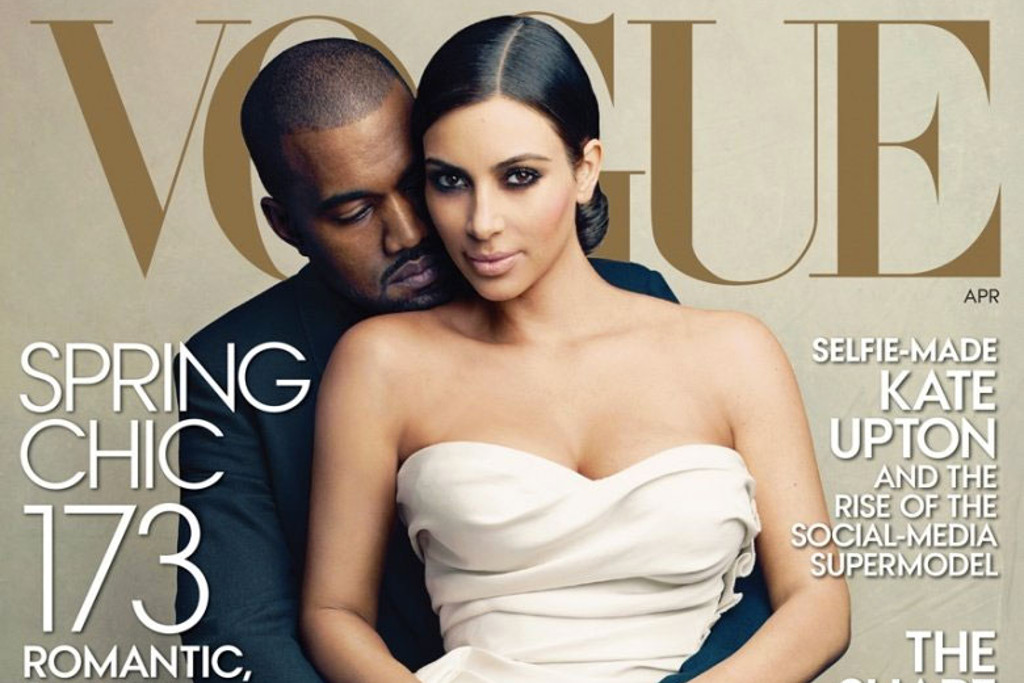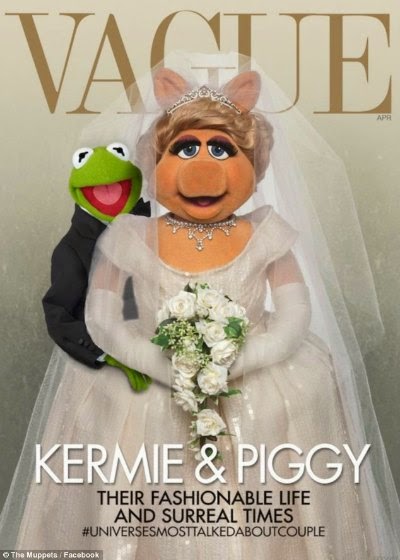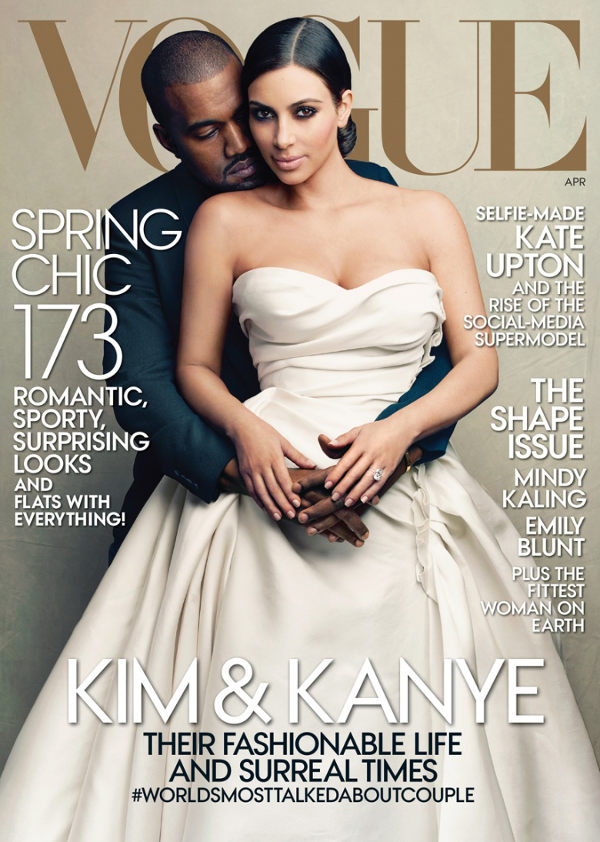Why Kimye’s Vogue Cover Actually Makes Perfect Sense
It's not the end of the world - or Vogue, for that matter. Like clickbait in 3D, it's just good business.

Sad news out of New York City: media pundits and inside sources are reporting that venerable “fashion bible” Vogue suddenly passed away over the weekend, aged 111.
The beloved monthly magazine and star of the hit 2009 documentary The September Issue apparently keeled over in its office high above Times Square, fatally weakened from an exhausting, years-long battle with reality TV star Kim Kardashian and her soon-to-be-husband Kanye West, who grace what now appears to be the publication’s last-ever cover.
–
Crimea and Venezuela are in crisis. Suicide bombers remain rampant in the Middle East. Asylum seekers are left in limbo in inhumane detention centres off Australian shores, and we still have no bloody clue where that plane went.
Yet even those good people whose lives are devoted to wilfully ignoring Kanye West and Kim Kardashian had their attention diverted over the weekend to the sound and fury that greeted Anna Wintour’s decision to finally put Kimye on the cover of Vogue — eliciting this grammatically-challenged reaction from Kim herself.
This is such a dream come true!!! Thank you @VogueMagazine for this cover! O M GGGGGG!!! I can’t even breath! http://t.co/0pCAs27GLl
— Kim Kardashian (@KimKardashian) March 21, 2014
You’d be hard-pressed to find a leading fashion designer, label head or style blogger who’ll speak ill of Wintour’s decision (at least out loud) because, well, they need to stay in Anna’s good graces. Everybody else, however, let rip.
Sex tape to Vogue cover. It’s the American dream.
— Mary Elizabeth (@TeamSmella23) March 21, 2014
Kanye West, Kim Kardashian and a hashtag on the cover of Vogue. This is the world we live in.
— Alex Goldschmidt (@alexandergold) March 21, 2014
Looks like Anna Wintour finally caved… Thoughts? #voguedoeskimye http://t.co/zgdZUDf7Cb
— Gilt.com (@Gilt) March 21, 2014
In the eyes of many longtime readers and insiders who hold Vogue as the industry’s publication nonpareil, Wintour had finally sold out. It’s long been rumoured she wanted nothing to do with the openly gauche Kim and Kanye; now she’d gone and handed them both the most coveted fashion magazine cover on the planet. It hasn’t gone over well.
Heresy!, they cried. Apocalypse!, they raged. Across the Internet — on message boards, comment threads, Twitter feeds and angry e-mail chains — mourning came en masse.
“RIP American Vogue,” wrote Dlisted’s Michael K. On the magazine’s own website, Nana71 declared “I am heartbroken at cancelling my subscription but see no other way.” Even Sarah Michelle Gellar, who parlayed her own Hollywood marriage into two live-action films about Scooby-Doo, expressed disgust.
Well……I guess I’m canceling my Vogue subscription. Who is with me???
— Sarah Michelle (@RealSMG) March 21, 2014
To which I say: get a grip. Because you know what a great magazine cover is supposed to do? Cause controversy. Challenge assumptions. Spark debate. Kinda like the print-media version of linkbait. There was a time when the industry — flush with money, resources, staff and creativity — accomplished those feats on a near-weekly basis; now most magazine editors are simply struggling to have a job, let alone a next issue to present to the world.
Anna Wintour Has Bigger Things To Worry About… Like Her Magazine’s Bottom Line
The realities of magazine publishing have been so fundamentally upended by the digital revolution, the GFC and the slow demise of the newsagent that Anna Wintour should be applauded for stirring the pot twice already this year.
First she showcased a subtly-Photoshopped Lena Dunham on the cover of her January issue, a polarising decision that set off a feminist firestorm. Now Wintour has gone and pissed off her readers by giving them exactly what they think they don’t want: a shot of the world’s most unrepentantly press-hungry power couple, locked in a (for them) tender embrace on the cover of a magazine that is supposed to be above all of this tabloid nonsense.
Do I like Kim Kardashian and Kanye West? Not one bit. They are narcissistic capitalists who seem interested in furthering the cause of nobody but themselves — in other words, they’re Americans. (Full disclosure: I’m one, too.) But is this cover an abomination, or even off-brand? Not exactly. Like them or not, Kim and Kanye have influenced the style decisions of millions and hold huge, unavoidable sway over the fashion-buying mainstream. Whether those decisions — or that mainstream — are in line with what the self-appointed arbiters of who belongs on the cover of Vogue find fashionable may actually be beside the point.
To many, only the truly stylish — whether they be First Ladies, iconic actresses, boundary-busting pop stars or successful supermodels — should be fronting issues of Vogue. I understand that. I also understand that much of the disgust with this cover stems from our own collective unease with the origins of Kim Kardashian’s fame and the incessant, headline-hungry outrage that has come to define Kanye West. He’s been on a tear for ages about his desire to see Kim fronting Vogue, and now he’s gotten his way. Plenty has been said (and plenty more will) about his masterful manipulation of the media. But now he’s pulled a fast one on the classiest readers in all of Magazineland? No wonder they’re angry.
But therein lies the rub: we need to stop pretending that the cover of Vogue is still a sacred place. It is an admirable idea to try and keep alive, but it is also wholly untenable. The days when you could simply slap a stunning, possibly unknown model in high-end clothes on the front and expect to sell a million copies are long gone, and Wintour faces innumerable pressures as she attempts to maintain relevancy in a tough, unforgiving marketplace.
In other words, beggars simply cannot be choosers — and Wintour now admits as much, albeit in more gilded terms. In her calm, reasoned editor’s letter, Wintour makes her point and makes it well: Kim and Kanye get us talking, even when we have absolutely no desire to be part of the conversation. “There’s barely a strand of the modern media that the Kardashian Wests haven’t been able to master, and for good reason,” she writes. She’s right.
The Sneaky (And Brilliant) Art Of Ticking The Readers Off
Wintour’s come-to-Jesus moment recalls a similar magazine maelstrom that erupted last month, when her closest competition in the Most Notorious Magazine Editor on Earth Pageant, Vanity Fair’s Graydon Carter, was also forced to explain a controversial decision.
In an editor’s letter so anticipated it actually prompted a cover headline, Carter told readers he’d decided to kill a reported essay on the love/hate phenomenon that is Gwyneth Paltrow. The story, he said, “had clearly gotten away from us” — by the time the unpublished copy was in his hands it had already “generated more mail and attention than many of the biggest stories we’ve ever published” from the pro- and anti-Gwynnie camps.
Paltrow had reportedly been on the warpath for months, calling and threatening friends against participating in what the likes of TMZ and RadarOnline were teasing would be an epic takedown of an editorial. Carter claimed the final version was “such a far cry from the almost mythical story that people were by now expecting that it was bound to be a disappointment. What to do?” He opted not to run it at all, disappointing everybody with a toothless explanation that “it’s a story I might read. I just don’t want to publish it.” (Might read? Really?)
Carter had every right to kill the story, but it was a pretty selfish decision — and a dishonest one at that. So the story was filed, he seemed to be saying. It probably wasn’t what you were expecting. I know because I read it. But you don’t get to. Nyahh-nyahh!
Wintour, on the other hand, had conviction enough to ignore the threats, listen to her instincts and throw a big ol’ bomb right at her well-heeled crowd of readers. Be as repulsed (or delighted) as you want with her. Get angry! Or hang the cover on your bedroom wall! At least you’re reacting.
And at least this happened, too.

–
Nicholas Fonseca is a freelance writer, and a former editor at Madison; prior to his arrival in Sydney, he was based in New York City, where he spent a decade as a staff member with Entertainment Weekly.
